The Telecom Power Rental Market is estimated to be valued at USD 1.8 billion in 2025 and is projected to reach USD 2.5 billion by 2035, registering a compound annual growth rate (CAGR) of 3.6% over the forecast period. Between 2025 and 2030, the market is expected to increase from USD 1.8 billion to USD 2.1 billion, driven by the rising demand for temporary power solutions in telecom infrastructure, particularly in remote and off-grid areas.
Year-on-year analysis shows steady growth, with values remaining at USD 1.8 billion in 2026, and increasing to USD 1.9 billion in 2027, supported by infrastructure expansion and demand for backup power solutions. By 2028, the market is expected to reach USD 2.0 billion, advancing to USD 2.0 billion in 2029 and USD 2.1 billion by 2030.
Growth will be further fueled by the increasing reliance on renewable energy solutions in telecom power rentals, along with innovations in energy storage systems. These dynamics position the telecom power rental market as a crucial component for supporting telecom infrastructure, offering sustainable and reliable power solutions for telecom operators globally.
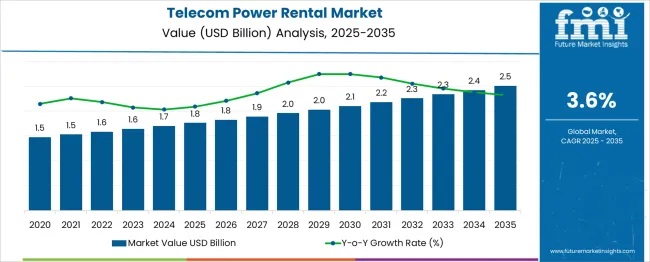
| Metric | Value |
|---|---|
| Telecom Power Rental Market Estimated Value in (2025 E) | USD 1.8 billion |
| Telecom Power Rental Market Forecast Value in (2035 F) | USD 2.5 billion |
| Forecast CAGR (2025 to 2035) | 3.6% |
The Telecom Power Rental market is undergoing significant expansion due to increasing demand for uninterrupted power supply across telecom networks, particularly in regions with unreliable grid infrastructure. The growing deployment of 4G and 5G networks, expansion of rural connectivity programs, and rapid growth of data consumption have made power continuity a critical operational requirement for telecom service providers.
Investments in telecom tower infrastructure in both developed and emerging economies are further fueling the need for flexible, cost-effective, and scalable power solutions. Power rental solutions are being preferred due to their ability to meet temporary, emergency, and peak load demands without long-term capital investment.
Additionally, stricter regulatory mandates for network uptime and the expansion of remote site installations have increased the adoption of rental power units across the telecom sector. As telecom networks modernize and expand, the power rental market is expected to continue its upward trajectory, driven by evolving energy needs and infrastructure growth across rural and urban areas..
The telecom power rental market is segmented by power rating, application, fuel, and geographic regions. By power rating of the telecom power rental market is divided into ≤ 75 kVA, > 75 kVA - 375 kVA, > 375 kVA - 750 kVA> 750 kVA. In terms of application, the telecom power rental market is classified into Standby, Peak shaving, and Prime/continuous. The telecom power rental market is segmented into Diesel, Gas, and Others. Regionally, the telecom power rental industry is classified into North America, Latin America, Western Europe, Eastern Europe, Balkan & Baltic Countries, Russia & Belarus, Central Asia, East Asia, South Asia & Pacific, and the Middle East & Africa.
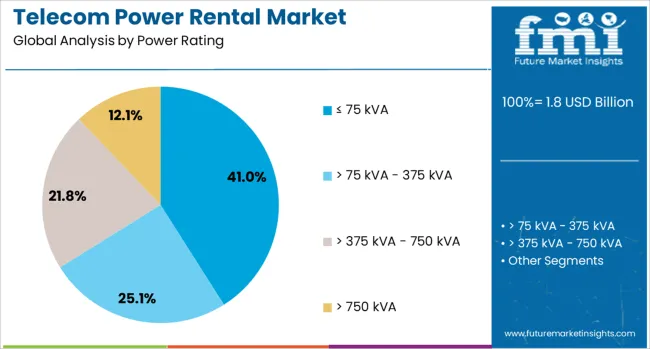
The power rating segment up to 75 kVA is projected to account for 41% of the Telecom Power Rental market revenue share in 2025. This segment’s dominance has been supported by the widespread use of low-capacity generator sets in remote telecom tower locations where grid access is either unreliable or unavailable. Smaller power-rated units have been recognized for their cost efficiency, fuel economy, and ease of transportation and deployment, especially in rural or semi-urban telecom zones.
These units are often selected to power single-site towers or micro base stations, which require limited but consistent energy. The compact design and low noise levels of ≤ 75 kVA systems have contributed to their suitability in densely populated or noise-sensitive zones.
Additionally, maintenance and operational simplicity has made this rating particularly attractive to telecom operators and third-party tower companies seeking minimal operational disruption. The ability to quickly scale power availability with lower-rated units has further reinforced their leadership within the power rating segment..
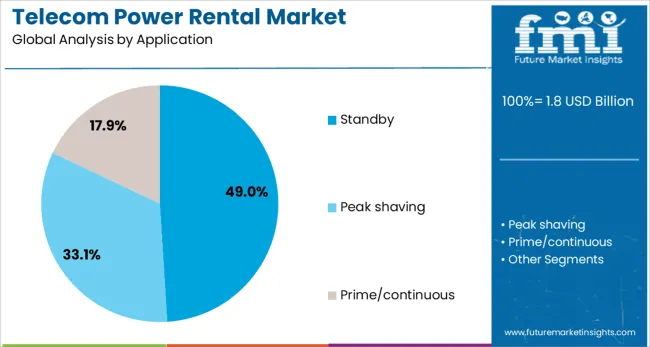
The standby application segment is expected to capture 49% of the Telecom Power Rental market revenue share in 2025, making it the leading application. The growth of this segment has been driven by the increasing requirement for emergency and backup power at telecom sites to prevent service disruptions during grid failures. Standby systems have been deployed widely to ensure network uptime, especially in areas prone to power outages due to weather, load shedding, or infrastructure limitations.
The rising number of rural telecom towers and small cell sites has intensified the need for dependable standby systems. These power rental units are maintained on-site for rapid activation, enabling uninterrupted communication services that are critical for both operational continuity and regulatory compliance.
The shift toward energy-as-a-service models has further encouraged telecom operators to rely on rented standby solutions to avoid upfront costs and operational risks. This cost-effective and reliable power assurance strategy has positioned the standby application segment as the preferred choice for modern telecom infrastructure..
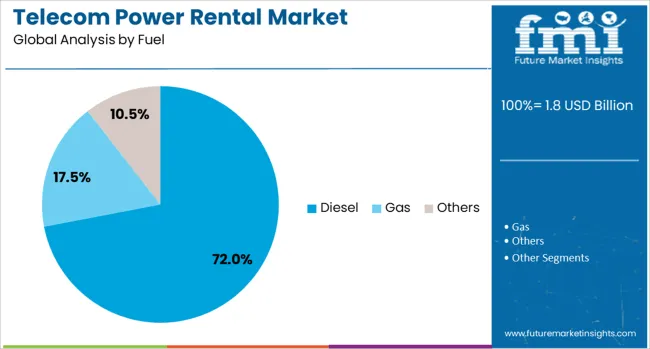
The diesel fuel segment is projected to lead the Telecom Power Rental market with a revenue share of 72% in 2025. Diesel generators have maintained their dominant position due to their proven reliability, high energy density, and adaptability to diverse climatic and geographical conditions. Telecom operators have relied heavily on diesel-powered rental systems to support network operations across remote and off-grid locations where alternative energy sources may be inconsistent or impractical.
The diesel segment’s scalability and fast response time have made it suitable for both temporary and long-term deployment scenarios. Despite growing interest in cleaner fuels, diesel continues to be favored due to its established supply chain, low initial setup costs, and ease of maintenance.
The ability of diesel-powered generators to deliver stable power during emergencies and fluctuating load conditions has further reinforced their application across a broad range of telecom sites. As network expansion continues across power-deficient areas, diesel fuel remains the primary energy source for rental power equipment in the telecom sector..
The telecom power rental market is driven by the growing demand for reliable power solutions as telecom networks expand, particularly with the rollout of 5G. Opportunities are rising in new infrastructure development, while trends toward energy-efficient and green power solutions are reshaping the market. However, high costs and reliance on external services present challenges. By 2025, addressing these challenges through cost-effective, sustainable power rental options will be essential for market growth and broader adoption.
The telecom power rental market is growing due to the rising demand for reliable power solutions in the telecom industry. With the expansion of telecom networks, particularly in remote or off-grid locations, temporary power systems are required to ensure continuous operation. The need for uninterrupted network services and the growing number of telecom towers are driving this demand. By 2025, the market is expected to continue benefiting from the telecom sector's focus on reliable power sources for expanding networks.
Opportunities in the telecom power rental market are increasing with the expansion of telecom infrastructure and 5G rollouts. The transition to 5G networks requires the installation of new telecom towers and infrastructure, often in areas without a stable power supply. Power rental solutions offer flexible and cost-effective alternatives to permanent installations. By 2025, the rollout of 5G networks, especially in developing regions, will drive the market's growth, as telecom operators seek temporary power solutions for new installations.
Emerging trends in the telecom power rental market highlight the increasing demand for green and energy-efficient solutions. As telecom companies face pressure to reduce their environmental impact, the adoption of solar-powered or hybrid power solutions is growing. These systems provide sustainable, low-emission alternatives to traditional generators. By 2025, eco-friendly telecom power rental solutions are expected to dominate the market, with companies prioritizing energy efficiency to meet regulatory standards and reduce operational costs.
Despite growth, challenges related to high rental costs and dependence on external power sources persist in the telecom power rental market. While power rental solutions are cost-effective for temporary use, long-term rental expenses can accumulate, making them less viable for extended periods. Additionally, reliance on external rental services for power can cause delays or disruptions in network operations. By 2025, addressing these cost and reliability concerns through improved rental models and energy storage solutions will be critical for the market's growth.
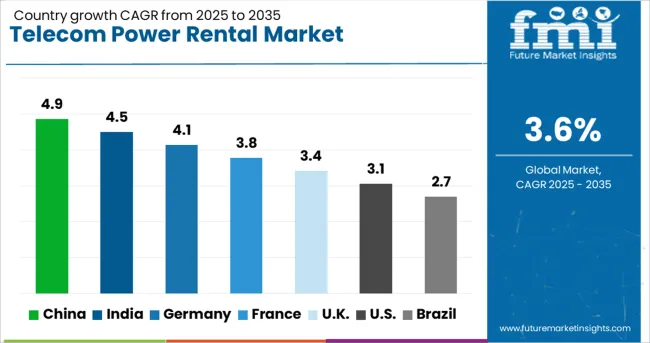
| Country | CAGR |
|---|---|
| China | 4.9% |
| India | 4.5% |
| Germany | 4.1% |
| France | 3.8% |
| UK | 3.4% |
| USA | 3.1% |
| Brazil | 2.7% |
The global telecom power rental market is projected to grow at a 3.6% CAGR from 2025 to 2035. China leads with a growth rate of 4.9%, followed by India at 4.5%, and France at 3.8%. The United Kingdom records a growth rate of 3.4%, while the United States shows the slowest growth at 3.1%. These varying growth rates are driven by factors such as the increasing demand for telecom infrastructure, the expansion of mobile networks, and the growing need for reliable power solutions in remote locations. Emerging markets like China and India are seeing higher growth due to expanding telecom sectors, infrastructure development, and rising mobile and internet usage, while more mature markets like the USA and the UK experience steady growth driven by established telecom networks and the increasing adoption of backup power systems. This report includes insights on 40+ countries; the top markets are shown here for reference.
The telecom power rental market in China is growing at a robust pace, with a projected CAGR of 4.9%. China’s rapidly expanding telecom infrastructure, combined with the growing demand for mobile and internet services, is driving the need for reliable power solutions. The country’s large-scale investments in 4G and 5G network rollouts, particularly in remote and rural areas, are significantly boosting the demand for telecom power rental services. Additionally, China’s focus on energy efficiency, renewable energy integration, and reducing the environmental impact of telecom operations further supports market growth in the power rental sector.
The telecom power rental market in India is projected to grow at a CAGR of 4.5%. India’s rapidly expanding telecom sector, driven by increasing mobile phone penetration, internet connectivity, and government initiatives for digital infrastructure development, is boosting the demand for power rental solutions. The need for reliable and efficient power systems in remote locations, coupled with the rising demand for backup power during grid failures, further accelerates market growth. Additionally, India’s focus on reducing carbon footprints and integrating renewable energy sources into telecom operations supports the increasing adoption of telecom power rental solutions.
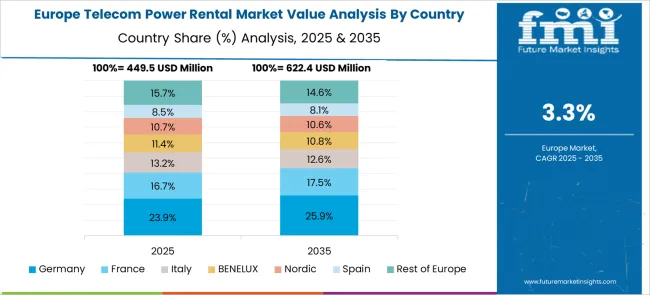
The telecom power rental market in France is projected to grow at a CAGR of 3.8%. France’s demand for telecom power rental solutions is primarily driven by the expansion of 4G and 5G networks, along with the need for reliable power systems in both urban and rural areas. The increasing adoption of backup power systems in mobile networks, as well as the country’s focus on reducing emissions and integrating sustainable energy sources into telecom infrastructure, is contributing to market growth. Additionally, France’s strong regulatory frameworks and commitments to energy efficiency are accelerating the demand for telecom power rental services.
The telecom power rental market in the United Kingdom is projected to grow at a CAGR of 3.4%. The UK’s telecom sector continues to demand reliable power solutions to support the expansion of 4G and 5G infrastructure, especially in remote and underserved areas. The need for backup power systems in mobile towers and base stations, combined with the growing focus on renewable energy sources, contributes to steady market growth. The UK’s commitment to sustainability, along with its growing mobile data consumption, ensures the continued adoption of telecom power rental services.
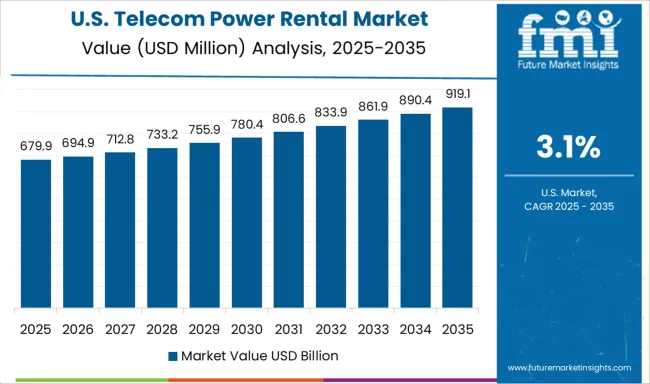
The telecom power rental market in the United States is expected to grow at a CAGR of 3.1%. The USA remains a key market for telecom power rental solutions, driven by the continued rollout of 4G and 5G networks, especially in rural and remote areas. The growing demand for backup power systems, particularly in mobile towers, base stations, and data centers, is contributing to steady market growth. Additionally, the USA’s focus on integrating renewable energy into telecom infrastructure and its commitment to reducing operational costs support the demand for energy-efficient and cost-effective power rental solutions.
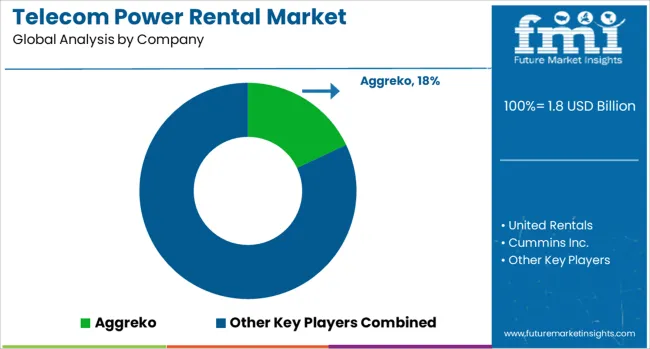
The telecom power rental market is dominated by Aggreko, which leads with its comprehensive range of power generation solutions designed specifically for the telecommunications industry. Aggreko’s dominance is supported by its global presence, extensive fleet of rental equipment, and expertise in providing temporary power solutions for telecom towers, network infrastructure, and data centers.
Key players such as United Rentals, Cummins Inc., and Generac Power Systems maintain significant market shares by offering reliable, scalable, and energy-efficient power rental systems for telecom operators in remote and urban locations. These companies focus on delivering flexible, cost-effective solutions that meet the increasing demand for uninterrupted power supply and minimize operational downtime.
Emerging players like APR Energy are expanding their market presence by providing customized power rental solutions designed for niche telecom applications, such as mobile network towers and off-grid locations. Their strategies include offering fast deployment, integrating renewable energy sources, and enhancing fuel efficiency to support sustainable telecom operations.
Market growth is driven by the rising demand for reliable and efficient power in telecom infrastructure, particularly in areas with unstable or no grid connection. Innovations in hybrid power systems, renewable energy integration, and remote monitoring technologies are expected to further shape competitive dynamics and drive growth in the global telecom power rental market.
In May 2024, Aggreko introduced the POWERMX range, featuring the world’s first three-engine 1.35 MVA generator integrated within a single ISO 20-ft container. This innovative solution is tailored for energy-intensive industries, offering flexible, efficient, and scalable power delivery.
| Item | Value |
|---|---|
| Quantitative Units | USD 1.8 Billion |
| Power Rating | ≤ 75 kVA, > 75 kVA - 375 kVA, > 375 kVA - 750 kVA, and > 750 kVA |
| Application | Standby, Peak shaving, and Prime/continuous |
| Fuel | Diesel, Gas, and Others |
| Regions Covered | North America, Europe, Asia-Pacific, Latin America, Middle East & Africa |
| Country Covered | United States, Canada, Germany, France, United Kingdom, China, Japan, India, Brazil, South Africa |
| Key Companies Profiled | Aggreko, United Rentals, Cummins Inc., Generac Power Systems, and APR Energy |
| Additional Attributes | Dollar sales by power source and application, demand dynamics across telecommunications, data centers, and emergency backup sectors, regional trends in telecom power rental adoption, innovation in fuel-efficient and hybrid power solutions, impact of regulatory standards on emissions and energy efficiency, and emerging use cases in 5G infrastructure and remote connectivity. |
The global telecom power rental market is estimated to be valued at USD 1.8 billion in 2025.
The market size for the telecom power rental market is projected to reach USD 2.5 billion by 2035.
The telecom power rental market is expected to grow at a 3.6% CAGR between 2025 and 2035.
The key product types in telecom power rental market are ≤ 75 kva, > 75 kva - 375 kva, > 375 kva - 750 kva and > 750 kva.
In terms of application, standby segment to command 49.0% share in the telecom power rental market in 2025.






Our Research Products

The "Full Research Suite" delivers actionable market intel, deep dives on markets or technologies, so clients act faster, cut risk, and unlock growth.

The Leaderboard benchmarks and ranks top vendors, classifying them as Established Leaders, Leading Challengers, or Disruptors & Challengers.

Locates where complements amplify value and substitutes erode it, forecasting net impact by horizon

We deliver granular, decision-grade intel: market sizing, 5-year forecasts, pricing, adoption, usage, revenue, and operational KPIs—plus competitor tracking, regulation, and value chains—across 60 countries broadly.

Spot the shifts before they hit your P&L. We track inflection points, adoption curves, pricing moves, and ecosystem plays to show where demand is heading, why it is changing, and what to do next across high-growth markets and disruptive tech

Real-time reads of user behavior. We track shifting priorities, perceptions of today’s and next-gen services, and provider experience, then pace how fast tech moves from trial to adoption, blending buyer, consumer, and channel inputs with social signals (#WhySwitch, #UX).

Partner with our analyst team to build a custom report designed around your business priorities. From analysing market trends to assessing competitors or crafting bespoke datasets, we tailor insights to your needs.
Supplier Intelligence
Discovery & Profiling
Capacity & Footprint
Performance & Risk
Compliance & Governance
Commercial Readiness
Who Supplies Whom
Scorecards & Shortlists
Playbooks & Docs
Category Intelligence
Definition & Scope
Demand & Use Cases
Cost Drivers
Market Structure
Supply Chain Map
Trade & Policy
Operating Norms
Deliverables
Buyer Intelligence
Account Basics
Spend & Scope
Procurement Model
Vendor Requirements
Terms & Policies
Entry Strategy
Pain Points & Triggers
Outputs
Pricing Analysis
Benchmarks
Trends
Should-Cost
Indexation
Landed Cost
Commercial Terms
Deliverables
Brand Analysis
Positioning & Value Prop
Share & Presence
Customer Evidence
Go-to-Market
Digital & Reputation
Compliance & Trust
KPIs & Gaps
Outputs
Full Research Suite comprises of:
Market outlook & trends analysis
Interviews & case studies
Strategic recommendations
Vendor profiles & capabilities analysis
5-year forecasts
8 regions and 60+ country-level data splits
Market segment data splits
12 months of continuous data updates
DELIVERED AS:
PDF EXCEL ONLINE
Power Rental Market Size and Share Forecast Outlook 2025 to 2035
Telecom Power Systems Market Size and Share Forecast Outlook 2025 to 2035
Telecom Tower Power System Market Size and Share Forecast Outlook 2025 to 2035
Telecom Tower Power System Market Analysis - Size, Share, and Forecast Outlook 2025 to 2035
Standby Power Rental Market Size and Share Forecast Outlook 2025 to 2035
Gas Fueled Power Rental Market Size and Share Forecast Outlook 2025 to 2035
Construction Power Rental Market Size and Share Forecast Outlook 2025 to 2035
Compact Power Equipment Rental Market Growth - Trends & Forecast 2025 to 2035
United States Telecom Tower Power System Market Trends & Forecast 2025 to 2035
Standby Gas Fueled Power Rental Market Size and Share Forecast Outlook 2025 to 2035
Prime Diesel Fueled Power Rental Market Size and Share Forecast Outlook 2025 to 2035
Peak Shaving Diesel Fueled Power Rental Market Size and Share Forecast Outlook 2025 to 2035
Telecom Site Management Software Market Size and Share Forecast Outlook 2025 to 2035
Power Grid Fault Prediction Service Market Size and Share Forecast Outlook 2025 to 2035
Power Plant Boiler Market Forecast Outlook 2025 to 2035
Power Ring Rolling Machine Market Size and Share Forecast Outlook 2025 to 2035
Power Supply Equipment for Data Center Market Size and Share Forecast Outlook 2025 to 2035
Power Electronics Market Size and Share Forecast Outlook 2025 to 2035
Power Quality Equipment Market Size and Share Forecast Outlook 2025 to 2035
Power Generator for Military Market Size and Share Forecast Outlook 2025 to 2035

Thank you!
You will receive an email from our Business Development Manager. Please be sure to check your SPAM/JUNK folder too.
Chat With
MaRIA